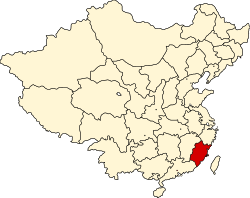Fujian Province, Republic of China
Fujian or Fukien Province ([fǔ.tɕjɛ̂n] (![]()
Fujian 福建省 | |
|---|---|
 Seal of Fujian Province | |
 Map showing subdivisions under administration of the nominal province in 2019 | |
| Coordinates: 24°25′N 118°19′E | |
| Country | |
| Jiangnandong Circuit | 626 |
| Fujian Circuit | 985 |
| Partition of Taiwan | 1887 |
| Fujian People's Government | 1933-11-20 to 1934-01-13 |
| Division of Fujian | 1949-08-17 |
| Streamlined | 1956-07-16 |
| Demilitarised | 1992-11-07 |
| Dissolved | 2018-12-31 |
| Named for | 福 Fú: Fuzhou 建 Jiàn: Jianzhou |
| Provincial capital | None[lower-alpha 1] |
| Government | |
| • Body | None[lower-alpha 2] |
| Area | |
| • Total | 180.4560 km2 (69.6745 sq mi) |
| Population (2014) | |
| • Total | 133,456 |
| • Density | 740/km2 (1,900/sq mi) |
| Demonym(s) | Fujianese, Fukienese, Kinmenese, Matsunese |
| Time zone | UTC+8 (Asia/Taipei) |
| Postal code | 209–212, 890–896 |
| Area code(s) | (0)82, (0)826, (0)836 |
| ISO 3166 code | TW |
| Counties | 2 |
| Website | www.fkpg.gov.tw |

The current Fujian Province under ROC control was once part of a larger Fujian Province, which consisted of a mainland portion and some islands. After the Chinese Civil War of 1949, the majority of the historical province became Fujian, People's Republic of China, while the remaining islands remained under ROC control, which compose 0.5% of the ROC's territories.
History
Imperial China
The Han dynasty collapsed at the end of the 2nd century AD, paving the way for the Three Kingdoms era. Sun Quan, the founder of the Kingdom of Wu, spent nearly twenty years subduing the Shan Yue people, the branch of the Yue living in mountains.
The first wave of immigration of the noble class arrived in the province in the early 4th century when the Western Jin dynasty collapsed and the north was torn apart by invasions by nomadic peoples from the north, as well as civil war. These immigrants were primarily from eight families in central China: Lin (林), Huang (黃), Chen (陳), Zheng (鄭), Zhan (詹), Qiu (邱), He (何), and Hu (胡). The first four remain as the major surnames of modern Fujian.
Nevertheless, isolation from nearby areas owing to rugged terrain contributed to Fujian's relatively backward economy and level of development, despite major population boost from northern China during the "barbarian" invasions. Population density in Fujian remained low compared to the rest of China. Only two commanderies and sixteen counties were established by the Western Jin dynasty. Like other southern provinces such as Guangdong, Guangxi, Guizhou, and Yunnan, Fujian often served as a destination for exiled prisoners and dissidents at that time.
During the Southern and Northern Dynasties era, the Southern Dynasties reigned south of the Yangtze River, including Fujian.
The Tang dynasty (618–907) oversaw the next golden age of China. As the Tang dynasty ended, China was torn apart in the period of the Five Dynasties and Ten Kingdoms. During this time, a second major wave of immigration arrived in the safe haven of Fujian, led by general Wang, who set up an independent Kingdom of Min with its capital in Fuzhou. After the death of the founding king, however, the kingdom suffered from internal strife, and was soon swallowed up by Southern Tang, another southern kingdom.[1]
Quanzhou was blooming into a seaport under the reign of the Min Kingdom, and is the largest seaport in the world. Its population is also greater than Fuzhou.[2][3] Due to the Ispah Rebellion, Quanzhou was severely damaged. In the early Ming dynasty, Quanzhou was the staging area and supply depot of Zheng He's naval expeditions. Further development was severely hampered by the sea trade ban of the Ming dynasty, and the area was superseded by nearby ports of Guangzhou, Hangzhou, Ningbo and Shanghai despite the lifting of the ban in 1550. Large scale piracy by Wokou (Japanese pirates) was eventually wiped out by Chinese military and Japanese authority of Toyotomi Hideyoshi.
Qing Dynasty
Late Ming and early Qing dynasty symbolized an era of large influx of refugees and another 20 years of sea trade ban under the Kangxi Emperor, a measure intended to counter the refuge Ming government of Koxinga in Taiwan. Incoming refugees, however, did not translate into a major labor force owing to their re-migration into prosperous regions of Guangdong. In 1683, the Qing dynasty conquered Taiwan and annexed it into Fujian province, as Taiwan Prefecture. Settlement of Taiwan by Han Chinese followed, and the majority of people in Taiwan are descendants of Hoklo people from Southern Fujian. Fujian arrived at its present extent after Taiwan was split as its own province in 1885.[4] Just ten more years later, Taiwan Province would be lost to Japan due to the Qing losing the First Sino-Japanese War which ended in 1895.
Republic of China
The Xinhai Revolution deposed the Qing dynasty brought the province into the rule of the Republic of China. Fujian briefly gained independence from China again under the Fujian People's Government until it was recontrolled by the ROC during the Warlord Era.
It came under Japanese sea blockade during Second Sino-Japanese War.
During the Chinese Civil War, the ROC lost control of mainland China, including most of Fujian province, and was forced to relocate to Taiwan, while the victorious Chinese Communist forces established the PRC in 1949, subsequently the capital of Fujian was also moved from Foochow to Jincheng. In the Battle of Guningtou, however, ROC forces were able to defend the island of Quemoy (Kinmen) just off the coast of Fujian from communist attack. As a result, the ROC has been able to hold on to a number of offshore islands of Fujian, and has continued to maintain a separate Fujian Provincial Government to govern these islands, parallel to the province of Fujian in mainland China.
In 1956, due to heightened potential for military conflict with the PRC, the ROC central government moved the Fujian provincial government out of Fujian to within Taiwan Province in Xindian (now part of New Taipei), and the islands were placed under an extraordinarily tight military administration due to their extreme proximity to mainland China. This was an unusual situation where the government of a province was located and operating in a different province. With the easing of cross-strait relations between the PRC and ROC and the democratization of the ROC in the 1990s, the islands were returned to civilian government in 1992. On January 15, 1996, the provincial government moved back to Kinmen, on Fujian soil.[5]
Recently, the ROC has significantly diluted the powers of the two provinces it governs, namely Taiwan and Fujian. Most of the authority at the Fujian province level has been delegated to the two county governments of Kinmen and Lienchiang.
Government
The Governor of Fujian Province was the head of the Fujian Provincial Government, the governor was also titled the "Chairperson of the Fujian Provincial Government". According to the Additional Articles of the Constitution, the governor is appointed by the central government.
The Fujian Provincial Government was located in Jincheng, Kinmen between January 1996 and 2018. In July 2018, the Executive Yuan decided to transfer the duties and functionalities of the provincial government to other branches under the Executive Yuan, including Kinmen-Matsu Joint Services Center[6] and National Development Council[7] The transformations were scheduled to be done by the end of year 2018.
Fujian Provincial Government building between January 1996 to 2018. Currently the Kinmen-Matsu Joint Services Center, Executive Yuan building. |
Subdivisions
Fujian province nominally comprises two counties: Kinmen County and Lienchiang County. These islands have a total area of 182.66 km2 (70.53 sq mi) and a total population of 71,000 (2001).
The following are the islands of Fujian under the administration of the ROC, given by county:
| Name | Kinmen County | Lienchiang County |
|---|---|---|
| Chinese | 金門縣 | 連江縣 |
| Hokkien | Kim-mn̂g-koān | Liân-kang-koān |
| Hakka | Kîm-mùn-yen | Lièn-kông-yen |
| Matsunese | Gĭng-muòng-gâing | Lièng-gŏng-gâing |
| Wuqiunese | Ging-meóng-gā̤ⁿ | Léng-gang-gā̤ⁿ |
| Map | .svg.png) | |
| Islands | numerous islands & islets[8][9][10] | 36 islands |
|
| |
| Administrative divisions | 6 townships | 4 townships |
The PRC claims Kinmen as a county of Quanzhou, Fujian and the Matsu Islands as a township of Lianjiang County, Fuzhou, Fujian (with some islands claimed as parts of other areas).
See also
Notes
- Between 1956 and 1996, Xindian City in Taipei County served as the seat of government.
References
- Fukien. (2008). In Encyclopedia Britannica. Retrieved December 20, 2008, from Encyclopædia Britannica Online: http://www.britannica.com/EBchecked/topic/221639/Fujian
- 伊本・白图泰(著)、马金鹏(译),《伊本・白图泰游记》,宁夏人民出版社,2005年
- "中国网事:千年古港福建"泉州港"被整合改名引网民争议". 新华网. Retrieved 2014-08-17.
- Skinner, George William; Baker, Hugh D. R. (1977). The City in late imperial China. Stanford University Press. p. 197. ISBN 978-0-8047-0892-0. Retrieved 19 January 2012.
- Fujian Provincial Government website Archived April 14, 2009, at the Wayback Machine
- "The personnel of the provincial government will be transferred to Kinmen-Matsu Joint Service Center, Executive Yuan". Retrieved 29 Nov 2018.
- "Taiwan Provincial Government Official Website". Retrieved 17 July 2018.
- 金門縣行政區域圖 (in Chinese). Retrieved 9 August 2019.
北碇島 母嶼 白巖 草嶼 東割 烽遂角 后嶼 官澳礁 西園嶼 建功嶼 黑巖 大巖嶼 烏礁 桂子礁 獅嶼 牛心礁 小擔 檳榔嶼 烈嶼 復興嶼 猛虎嶼 兔嶼 石山 大膽島 二擔島 三擔島 四擔島 五擔 大坵島 小坵島
- "金門地區限制(禁止)水域圖" (PDF) (in Chinese). Mainland Affairs Council. Retrieved 9 August 2019.
二.限制水域範圍:大金門地區低潮線向外延伸東方海面四千至六千公尺,南方海面八千至一萬公尺,北碇以東海面四千公 尺,大、二膽南海面二千公尺一線以內海域 三、禁止水域範圍:大金門地區低潮線向外延伸東方海面四千公尺,南方海面八千公尺,馬山北方一千五百公尺,北碇以東 海面四千公尺,大、二膽北、西、南海面二千公尺,小金門西海面、檳榔嶼、三腳礁、牛心礁、赤角礁一線以內海域
- 辞海第六版. Cihai (Sixth Edition) (in Chinese). 上海. Shanghai: 上海辞书出版社. Shanghai Lexicographical Publishing House. September 2009. p. 1124. ISBN 9787532628599.
金门 县名。在福建省东南海上、泉州市西南部。现由台湾省管辖。由以金门岛为主的大、小59个岛屿组成。面积149平方千米,人口约6.45万(2004年)。明置金门千户所,清设金门县丞,属同安县。1913年改隶思明县,1914年析置金门县。1928年直属福建省。农产有甘薯、花生等。矿产有玻璃砂、高岭土、铝土、煤。工业有机械、食品等。特产贡糖、高粱酒、金门马等。通公路。名胜古迹有成功洞、鲁王墓、水尾塔等。{...}金门岛 亦称“大金门岛”、“吾洲屿”。在福建省东南部、厦门港口外台湾海峡中。属金门县,现由台湾省管辖。岛形如哑铃,东西宽,南北狭,中多丘陵,沿海多港湾、口岸。东西长约20千米,面积131.7平方千米。其西有小金门岛。名胜古迹有牧马侯(陈渊)祠、鲁王墓、海印寺、古岗湖、中山纪念林等。
External links
| Wikimedia Commons has media related to Fujian Province, Republic of China. |
- ROC Fujian Provincial Government (in Chinese)


.svg.png)